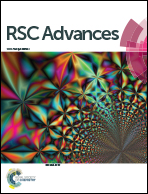Highly permeable ionic liquid membrane by both facilitated transport and the increase of diffusivity through porous materials
Abstract
Ionic liquid membranes have showed low permeance, due to high viscosity when utilized for gas separation, limiting their practical application despite advantages such as high thermal stability and high CO2 selectivity. In this study, Cu nanoparticles generated by redox reduction with Fe2+ ions and porous KIT-6 were utilized for high selectivity and as a permeable membrane. When positively polarized Cu nanoparticles were generated and porous KIT-6 materials were incorporated into ionic liquid 1-butyl-3-methyl imidazolium tetrafluoroborate (BMIM BF4), the selectivity for CO2/N2 and CO2/CH4 of the composite membrane was largely enhanced to 16.4 and 23.4, respectively while neat BMIM BF4 was 5.0 and 4.8, respectively. Furthermore, the CO2 permeance was also enhanced from 17 to 50.7 GPU, compared to the neat BMIM BF4 membrane. These enhancements of separation performance is attributed to both the facilitated transport by polarized Cu NPs and the increase of diffusivity by porous materials.


 Please wait while we load your content...
Please wait while we load your content...